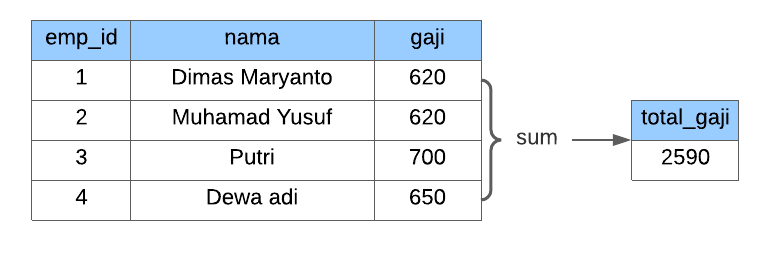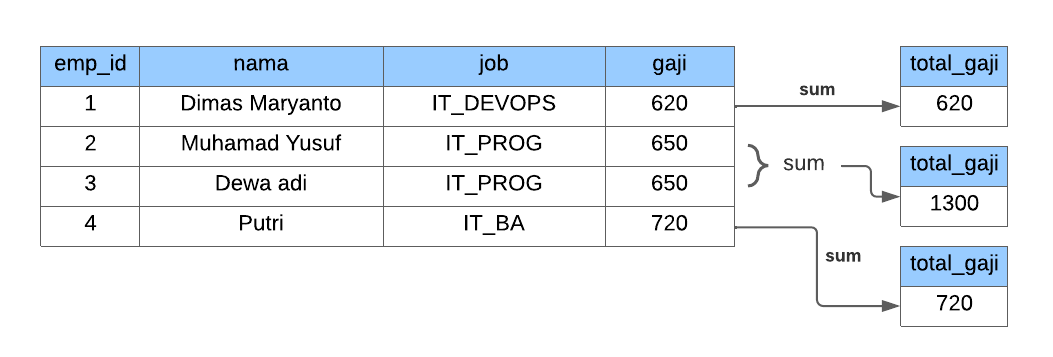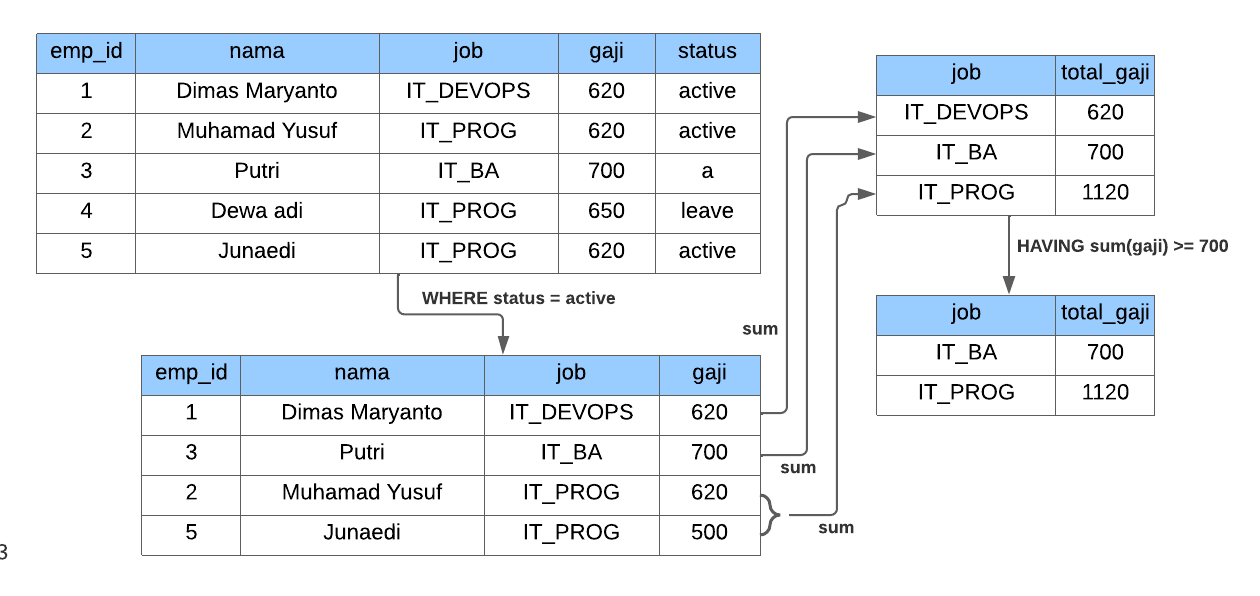Single Row / Group functions
Hai semuanya, di materi kali ini kita akan membahas tentang Jenis dari Functions yaitu Single Row Function dan Group Functions. Karena materinya akan lumayan panjang seperti biasa kita akan bagi menjadi beberapa bagian diantaranya:
- Using single row functions
- Using Group / Aggregate functions
- Using
GROUP BYclause - Using
HAVINGclause - Different between
WHEREandHAVINGclause? - Using
GROUPING SETclause
Ok langsung aja kita bahas materi yang pertama
Using single row functions
Single row function is Functions return a single result row for every row of a queried table or view.

Single row function yang kita bisa gunakan, ada banyak sekali sesuai dengan apa yang telah kita bahas di artikel sebelumnya ataupun kita juga bisa menggunakan function yang kita buat sendiri. These functions can appear in select lists, WHERE clauses, With Queries and more.
Contoh penggunaannya seperti berikut:
Jika dijalankan maka hasilnya seperti berikut:
hr=# SELECT UPPER(last_name) nama,
hr-# to_char(salary, '$L999,999.00') gaji_sebulan,
hr-# concat(first_name, ' ', last_name) as nama_lengkap
hr-# FROM employees
hr-# LIMIT 10;
nama | gaji_sebulan | nama_lengkap
-----------+---------------+------------------
KING | $ 24,000.00 | Steven King
KOCHHAR | $ 17,000.00 | Neena Kochhar
DE HAAN | $ 17,000.00 | Lex De Haan
HUNOLD | $ 9,000.00 | Alexander Hunold
ERNST | $ 6,000.00 | Bruce Ernst
AUSTIN | $ 4,800.00 | David Austin
PATABALLA | $ 4,800.00 | Valli Pataballa
LORENTZ | $ 4,200.00 | Diana Lorentz
GREENBERG | $ 12,000.00 | Nancy Greenberg
FAVIET | $ 9,000.00 | Daniel Faviet
(10 rows)
Using Group / Aggregate functions
Aggregate functions compute a single result from a set of input values. Jika kita gambarkan ilustrasinya seperti berikut:

Group atau Aggregate function di bagi menjadi beberapa diantaranya:
- General-Purpose Aggregate Functions
- Aggregate Functions for Statistics
- Ordered-Set Aggregate Functions
- Hypothetical-Set Aggregate Functions
- Grouping Operations
Untuk general purpose aggregate function berikut adalah beberapa function yang paling umum di gunakan:
| Functions | Description |
|---|---|
avg ( numeric ) → numeric |
Computes the average (arithmetic mean) of all the non-null input values. |
bool_and ( boolean ) → boolean |
Returns true if all non-null input values are true, otherwise false. |
bool_or ( boolean ) → boolean |
Returns true if any non-null input value is true, otherwise false. |
count ( "any" ) → bigint |
Computes the number of input rows in which the input value is not null. |
max ( any ) → same as input type |
Computes the maximum of the non-null input values. Available for any numeric, string, date/time, or enum type, as well as inet, interval, money, oid, pg_lsn, tid, and arrays of any of these types. |
min ( any ) → same as input type |
Computes the minimum of the non-null input values. Available for any numeric, string, date/time, or enum type, as well as inet, interval, money, oid, pg_lsn, tid, and arrays of any of these types. |
sum ( number ) → same as input type |
Computes the sum of the non-null input values. |
Sedangkan untuk Statistic purpose berikut adalah beberapa function yang paling umum di gunakan:
| Functions | Description |
|---|---|
corr ( Y double , X double ) → double |
Computes the correlation coefficient. |
stddev ( numeric_type ) → double |
This is a historical alias for stddev_samp. |
variance ( numeric_type ) → double |
This is a historical alias for var_samp. |
Dan masih banyak lagi, Berikut adalah contoh penggunaanya di SQL:
Jika dijalankan hasilnya seperti berikut:
hr=# SELECT max(salary) max_salary,
hr-# min(salary) min_salary,
hr-# avg(salary) avg_salary,
hr-# count(*) count_employees
hr-# FROM employees;
max_salary | min_salary | avg_salary | count_employees
------------+------------+-----------------------+-----------------
24000.00 | 2100.00 | 6461.6822429906542056 | 107
(1 row)
Using GROUP BY clause
The GROUP BY clause is used to group together those rows in a table that have the same values in all the columns listed. Jika di gambarkan berikut ilustrasinya

Untuk basic usage seperti berikut:
SELECT select_list
FROM ...
[WHERE ...]
GROUP BY grouping_column_reference [, grouping_column_reference]...The effect is to combine each set of rows having common values into one group row that represents all rows in the group. Berikut adalah contoh penggunaanya di SQL:
Jika dijalankan hasilnya seperti berikut:
hr=# SELECT job_id
hr-# FROM employees
hr-# GROUP BY job_id;
job_id
------------
SH_CLERK
AD_VP
SA_MAN
PR_REP
MK_REP
AD_PRES
FI_ACCOUNT
AC_ACCOUNT
(19 rows)
NOTE: Grouping without aggregate expressions effectively calculates the set of distinct values in a column.
In general, if a table is grouped, columns that are not listed in GROUP BY cannot be referenced except in aggregate expressions. An example with aggregate expressions is:
Jika dijalankan hasilnya seperti berikut:
hr=# SELECT job_id,
hr-# count(*) count_employees_by_job,
hr-# sum(salary) salary_group_by_job
hr-# FROM employees
hr-# GROUP BY job_id;
job_id | count_employees_by_job | salary_group_by_job
------------+------------------------+---------------------
SH_CLERK | 20 | 64300.00
AD_VP | 2 | 34000.00
SA_MAN | 5 | 61000.00
PU_MAN | 1 | 11000.00
IT_PROG | 5 | 28800.00
ST_CLERK | 20 | 55700.00
MK_REP | 1 | 6000.00
AD_PRES | 1 | 24000.00
FI_ACCOUNT | 5 | 39600.00
AC_ACCOUNT | 1 | 8300.00
(19 rows)
Using HAVING clause
If a table has been grouped using GROUP BY, but only certain groups are of interest, the HAVING clause can be used, much like a WHERE clause, to eliminate groups from the result.
The syntax is:
SELECT select_list
FROM ...
[WHERE ...]
GROUP BY ...
HAVING boolean_expressionExpressions in the HAVING clause can refer both to grouped expressions and to ungrouped expressions (which necessarily involve an aggregate function). Berikut adalah contoh penggunaanya di SQL:
Jika dijalankan hasilnya seperti berikut:
hr=# SELECT job_id,
hr-# count(*) count_employees_by_job,
hr-# sum(salary) salary_group_by_job
hr-# FROM employees
hr-# GROUP BY job_id
hr-# HAVING count(*) >= 5;
job_id | count_employees_by_job | salary_group_by_job
------------+------------------------+---------------------
SH_CLERK | 20 | 64300.00
SA_MAN | 5 | 61000.00
IT_PROG | 5 | 28800.00
ST_CLERK | 20 | 55700.00
PU_CLERK | 5 | 13900.00
ST_MAN | 5 | 36400.00
SA_REP | 30 | 250500.00
FI_ACCOUNT | 5 | 39600.00
(8 rows)
Different between WHERE and HAVING clause?
Mungkin dari temen-temen ada yang bertanya? jika menggunakan HAVING clause apa bedanya dengan WHERE clause?
Untuk mengetahui jawabanya kita kita perhatikan ilustrasi berikut:

Jadi klausa dengan WHERE dia prosesnya akan melakukan filter terlebih dahulu sebelum dilakukan proses GROUP BY sedangkan untuk HAVING dia akan memfilter datanya setelah dikelompokan / grouping. Berikut adalah contoh penggunaanya di SQL:
Jika dijalankan hasilnya seperti berikut:
hr=# SELECT job_id,
hr-# count(*) count_employees_by_job,
hr-# sum(salary) salary_group_by_job
hr-# FROM employees
hr-# WHERE job_id in ('FI_ACCOUNT', 'SA_MAN', 'IT_PROG', 'HR_REP', 'MK_MAN')
hr-# GROUP BY job_id
hr-# HAVING sum(salary) >= 20000;
job_id | count_employees_by_job | salary_group_by_job
------------+------------------------+---------------------
SA_MAN | 5 | 61000.00
IT_PROG | 5 | 28800.00
FI_ACCOUNT | 5 | 39600.00
(3 rows)
Using GROUPING SET clause
More complex grouping operations than those described above are possible using the concept of grouping sets.
The data selected by the FROM and WHERE clauses is grouped separately by each specified grouping set, aggregates computed for each group just as for simple GROUP BY clauses, and then the results returned. Berikut adalah contoh penggunaanya di SQL:
Jika dijalankan hasilnya seperti berikut:
hr=# SELECT manager_id, department_id, count(*), sum(salary)
hr-# FROM employees
hr-# GROUP BY GROUPING SETS ((manager_id), (department_id));
manager_id | department_id | count | sum
------------+---------------+-------+-----------
103 | | 4 | 19800.00
| | 1 | 24000.00
101 | | 5 | 44900.00
122 | | 8 | 23600.00
121 | | 8 | 25400.00
114 | | 5 | 13900.00
102 | | 1 | 9000.00
205 | | 1 | 8300.00
146 | | 6 | 51000.00
108 | | 5 | 39600.00
147 | | 6 | 46600.00
201 | | 1 | 6000.00
120 | | 8 | 22100.00
100 | | 14 | 155400.00
124 | | 8 | 23000.00
145 | | 6 | 51000.00
123 | | 8 | 25900.00
148 | | 6 | 51900.00
149 | | 6 | 50000.00
| 70 | 1 | 10000.00
| 80 | 34 | 304500.00
| 20 | 2 | 19000.00
| 10 | 1 | 4400.00
| | 1 | 7000.00
| 90 | 3 | 58000.00
| 100 | 6 | 51600.00
| 110 | 2 | 20300.00
| 30 | 6 | 24900.00
| 50 | 45 | 156400.00
| 40 | 1 | 6500.00
| 60 | 5 | 28800.00
(31 rows)
Jika kita perhatikan query tersebut sama jika kita menjalankan 2 query tetapi hasilnya digabungkan menjadi 1 result sets, seperti berikut:
select manager_id, count(*), sum(salary)
from employees
group by manager_id;
select department_id, count(*), sum(salary)
from employees
group by department_id;



